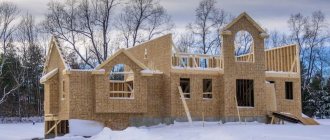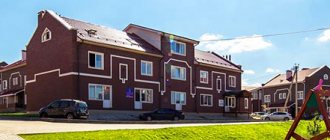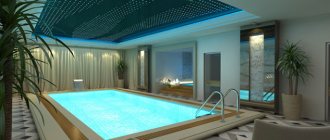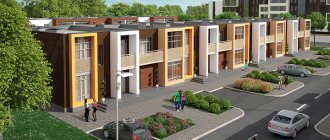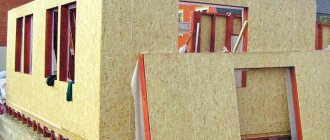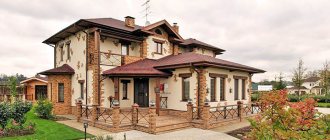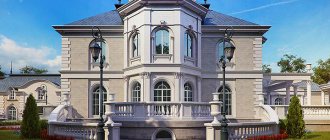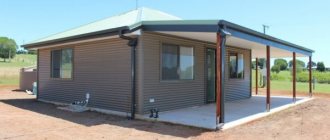Why is it better to entrust the development of a house project to architects?
Home design experts will help bring your design ideas from imagination to drawing board; they will be able to create a design that suits you and consider any possible obstacles. Their knowledge and experience can inform the design - after all, what they design will be the place you call home - so choosing the right architect for you is perhaps one of the most important decisions you will make.
Before you decide to contact architects, you need to have some background information. The architect will want to know what you need so they can determine if they are interested in taking on the project.
You don't need to have a list of everything you want installed in your future home, but this idea is useful for at least guiding your architect in the right direction:
- number of bedrooms;
- number of bathrooms;
- architectural styles that you like;
- materials you prefer;
- Are you for or against an open plan?
4. Find an Architect Who Has Experience Working with Designers
When choosing an architect, it can be of great importance if they have previous (successful) experience working with local planners.
While building permits for individual projects will always be controversial, whether your project is small or large and detailed, it pays to have someone fight your corner who is familiar with your planning administration - they will know what can or can't get approval, they have an understanding of the success of other projects in the area, and build relationships with those who decide your fate.
Where to find an architect?
Searching on the Internet
When it comes to finding an architect for your project, one of the easiest ways to do this is to simply search on Yandex or Google, taking into account your location.
Don’t forget about social networks: the same Instagram has teamed up with architects and designers demonstrating their work. Instagram collaborates with architects and designers to showcase their work. If you find something you like, they will likely have contact information on these platforms where you can contact them and discuss things in more detail.
Recommendations
It's best if you hire someone to work on your project who is recommended by people you know and trust (and this goes for not only architects, but also designers, builders, carpenters, etc.). Ask your friends and acquaintances, work colleagues, perhaps they have worked with an architect whom they could recommend.
5. Find an Architect Whose Previous Work You Admire
These days, one of the easiest and fastest ways to view an architect's previous work is through their website.
The practice's website will be their main sales tool, and you'll likely be able to view several well-photographed projects. This will give you an idea of the quality of work they perform, the architectural style they may specialize in, the materials they are familiar with, and the building systems they are used to working with.
It is important that you like their work and know that they can create the style of home you want.
How to behave in negotiations with an architect?
Your architect is the person you trust to design your dream home. You will be investing a lot of money not only in the project, but also in the design and materials, and you need to be sure that you can get closer to your ideal.
When you are interviewing various architects for a job, one of the deciding factors should be whether you deliver and whether you are confident enough that you can approach them and everything will work fine.
A breakdown in communication can have a lasting impact on the entire project, so when choosing an architect, make sure you can depend on them and that you are comfortable with them.
How to choose an architect and build a modern house: interview
The most famous architectural projects completed by the b720 team are the Agbar and the Santos Porta Fira in Barcelona, Lleida-Alguaire in Lleida and Velazco Astete in Peru, the casino in Costa Bravo and the reconstruction of Plaza del Torico in Teruel. The design bureau adheres to the principles of respect for the environment and energy-efficient construction.
About the present of architecture
— Fermin, this is your first time in Moscow. Which Moscow architectural structures did you note from a professional point of view?
— At the School of Architecture in Barcelona I studied the design and architecture of the Moscow metro. Now I saw it with my own eyes - and I was amazed! It's truly impressive! Of course, I couldn’t help but appreciate the center of Moscow, Red Square, and the Kremlin.
— What architects’ works inspire you?
— I like the works of many, not only Spaniards. Architecture in general is a combination of a number of components: cultural, visual, landscape. This is a complex cocktail that is mixed differently each time.
My teacher at the School of Architecture in Madrid, the architect Francisco Javier Saenz de Oiza, had a strong influence on me professionally and personally. The Torres Blancas de Madrid building , which he built in the 60s, is still an icon of Spanish avant-garde architecture. Another famous building is Torre del Banco de Bilbao . True, I never believed in the existence of a calling, I did not believe that a child is predetermined from birth to one occupation. I have always been interested in science, and at the same time I was interested in philosophy. Architecture, in my opinion, successfully combines scientific and philosophical components. That's why I decided to become an architect.
— What changes are taking place in the architecture of a modern home?
— In my opinion, private houses have not changed much. Changes have occurred in the people who live in these houses. Now the question is not whether they are rich or poor. Unlike the traditional families of the past, many new family models and new combinations are emerging. A family can consist of one person, an older couple, a group of young people living together, one parent raising a child... All these families have different needs, so they need different homes. A private house is changing in this direction, taking into account the needs of a particular family.
— Urban apartment buildings are designed for a large number of families and offer everyone the same living conditions. Is it possible in this case to take into account the needs of different family models?
“As for the general idea, the same diverse family models and diverse needs are present here. But... people prefer to buy standard housing. Why? The reason is simple - they want to be sure that they can sell it, if necessary, at any time, that is, convert it back into money.
— Modern buildings are often subject to harsh criticism, since modern materials that are used in construction are not designed for long-term use, “for centuries.”
— Materials are a rather complex issue. Everyone loves traditional cities, old centers - they are beautiful and cozy. At the same time, urban growth has been incredibly rapid over the past 60 years. Previously, people had a fairly limited list of natural materials - wood, stone, clay... And they studied them for decades, even centuries, and learned to process them.
What's happening now? The speed of our development has increased tenfold, and we must keep up. We must build much faster. To meet new needs, materials and technologies must change. Important aspects of modern construction are shorter construction times and the ability to repurpose a building during operation. Therefore, a dilemma arises - either build expensively and last for centuries, or in such a way that the building can be quickly demolished or repurposed, meeting modern demands.
There is also a philosophical approach: historical buildings were built in times when there was very little change, people were convinced that they would live like this forever. Now the situation is exactly the opposite. Man and society must be very mobile, the same applies to architecture.
— During construction, the environmental component is increasingly being taken into account. Which eco-trends do you think are the most important and viable?
— In the projects of the b720 bureau adheres to the principles of sustainable architecture , that is, environmentally sustainable technologies are used in construction. Of course, the most environmentally friendly building is the one that was not built at all. But since society needs a large number of buildings, we see one of the main tasks in reducing and preventing negative impacts on the environment.
Now there are many projects in which it is necessary to improve energy consumption indicators in already finished buildings. Most older spaces are not energy efficient. Moreover, this problem is relevant not only for Russia, but also for anywhere in the world. We work in many countries and see it almost everywhere. We still heat or cool not only ourselves, but also the outside, burning a lot of energy.
One of the cool modern ideas is the construction of green walls and roofs in buildings. This is an excellent solution, especially for the city. The advantage of a green roof in use is that it is well insulated, reduces the greenhouse effect, emissions and energy consumption. I am a proponent of a large number of green roofs and roofs with solar collectors. From an architectural point of view, this is a fairly simple technology. At the same time, such a roof is very stable, stable, and conditions for long-term operation are created on it.
— One of your bureau’s projects is the Lleida-Alguaire airport in Catalonia. Its design is distinguished by unusual geometry and style . How did this idea come about?
— The design was “fitted” into the surrounding landscape. From a bird's eye view, the surrounding fields look like a patchwork quilt. When developing the airport design, we used the same colors and patchwork. In addition, Lleida-Alguaire is the first Spanish airport to receive an energy certificate. We used a similar approach when creating an airport in Peru, where we were inspired by nature, mountains, and preserved ancient walls.
About future
— In what direction is architecture going, what will our houses look like in 50 years?
— Sometimes people think that an architect is a person who knows something about the future. In fact, we reflect the present, architects are terrible “predictors” (though economists are even worse). We work for the needs of society, here and now. In architecture we can see a modern cross-section of society.
I have been to a huge number of cities, lived in many cities around the world - Madrid, Barcelona, London, Chicago. And I come to the conclusion that the future lies in cities. Moreover, the cities will be densely populated. Therefore, it is important to organize cities and life in them so rationally that people feel comfortable in them and that the cities themselves develop stably.
— How to choose the ideal architect to build your house? Who can understand your needs?
- I'll give you two pieces of advice. First, you need to find a person who will listen to you, second, you need to trust him and not interfere. Then he will do the best he can. The main problems arise because there are architects who do not listen. And there are clients who don’t trust.
We would like to thank ROCKWOOL for their assistance in organizing the interview with Fermin Vazquez
What about the money?
Habr Career analyzed more than 10,000 salaries of IT specialists for the second half of 2021, and this is what happened →.
habr.com
- The median salary in the IT industry is now 113,000 rubles.
- developers receive on average 120,000 rubles.
- Among developers, software architects traditionally earn the most (RUB 200,000).
What types of architects are there (types and types)
By type: functional and technical.
Functional (or system) architect - finds out the requirements for the project and drafts the architecture for the system or software. Coordinates the process. Guru in hardware, data centers, networking, storage systems and server platforms.
Technical architect - communicates with developers, creates a system.
But in practice it's 2 in 1.
By type:
- Enterprise Architect
- Solution architect
- Infrastructure Architect
- Data Architect
Enterprise architect (answers the question “what to do?”)
Solve strategic problems - analyzes key requirements, data flows, writes the project constitution. Develops architectural standards and requirements.
Solution architect (“how to do it?”)
Selects frameworks, formulates alternative solutions, identifies risks, resolves controversial situations. Tests performance and security. He clearly envisions the implementation of an idea and conveys it to the team. Keeps the development team within the terms of reference. Knows what resources are required and how to quickly recover a fallen service.
Infrastructure architects (“what to do and why?”)
Deals with server hardware (application servers, support), databases, security architecture (authorization, authentication), cloud services.
This architect can be divided into:
Security architect is a specialist in security issues (closing access at the equipment level, encrypting data transmission channels and applied protection at the application level, mail or corporate applications).
Network architect - maintains the data transmission infrastructure.
Cloud systems architect - indicates which resources and in what volume to take from AWS, AZURE, Google, Yandex.
Data architects (“who will break it down into pieces?”)
Collects data from numerous sources, knows how to systematize it in a data lake, what data to put in a corporate storage and how to place it, and can get the necessary data.
What about life?
In practice, the boundaries between the types and types of architects are erased and almost always you need both a reaper and a player on the pipe. In large companies you can find all types and types, in small ones it’s a three-in-one specialist .
Carry out a major redevelopment
Here, too, you will need at least a consultation with an architect. To combine a room with the demolition of part of the load-bearing walls, to organize a kitchen on a glassed-in loggia, to coordinate additional window or door openings - all these manipulations must be carried out in accordance with safety requirements. Large-scale redevelopments are coordinated with the BTI, gas and other services responsible for the operation of communications in residential buildings. Your reconstructions should not harm the load-bearing capacity of walls and ceilings or disrupt the operation of intra-house systems. In this case, the architect’s task is to find a high-quality compromise between the customer’s wishes and the requirements of building regulations.
Personality and expenses
When searching for an architect, many investors set the cost of the service as the main selection factor. Of course, we all more or less rely on price, but should we make a decision based on that? We think not.
So what is this “magic” factor that makes us sign a contract with one architect? It's definitely his personality.
The decision to choose an architect depends primarily on our emotions. Individuality and approach to your work may be the decisive reason for your choice. On the other hand, however, impressions of a person should not obscure healthy, cool judgment. We will try to list here a number of issues that you should consider when meeting with your architect for an intake interview.
Instead of results
In the modern world, it has long been obvious: we need to strive to make everyone comfortable. The world is becoming more open, living standards are rising, and those categories of citizens who were previously not so active (for example, pensioners or mothers with small children) strive to live life to the fullest. This means that the surrounding spaces must meet the needs of motorists, pedestrians, mothers with strollers, and pensioners.
It is possible to qualitatively transform the urban and suburban environment only with the help of competent, experienced and modern specialists: architects, urban planners, landscape designers. It is these people who work to ensure that the space around them is environmentally friendly, functional, friendly and beautiful. Therefore, the demand for specialist architects will grow, which means that today young people should think about their future profession and, perhaps, make a choice in favor of architecture.
Creation of interior decor
The designer also has a specific part of the work - the selection and creation of the decorative component of the interior. Textiles, sculpture, accessories, furniture - they can either be selected from store catalogs and designer workshops, or created to order according to the designer’s sketches. This is a separate area of work, implying the selection of materials and drawing up technical specifications for the production part of the implementation of the plan. For example, if this is the creation of a unique set of textiles, forged furniture elements or wooden decorations.
A little history
The profession of an architect dates back several thousand years, because we know that people began to build since ancient times. The most grandiose ancient buildings were three types of buildings: where God lives, where the king lives, and where gold lives. That is, temples, palaces and treasuries. Science considers Imhotep : he supervised the construction of the pyramid of Djoser. This was in the third millennium BC.
The profession of an architect became especially important with the development of cities or, as they were called in Ancient Greece, policies. There is a legend that the first urban plan was created by order of Alexander the Great . The great king of Oikumene called on the architects to draw him a plan for the future city of Pharos. Even then, architects knew much of what was needed for design to this day. In particular, when planning streets, you need to take into account the terrain, as well as the direction of the winds that blow there.
Unfortunately, history does not know the names of those who built the great Gothic cathedrals of the Middle Ages. Although such assumptions are made by historians. Apparently, this is due to the enormous influence of the church, which did not welcome self-promotion and demonstration of authorship. But during the Renaissance, the profession of an architect was, on the contrary, very respected and as prestigious as the profession of an artist and sculptor. the most outstanding names such as Filippo Brunelleschi , Donato Bramante , Michelangelo Buanarotti and others. To this day, buildings erected according to the designs of famous Renaissance architects amaze with their beauty, harmony, grandeur and attract tourists from all over the world.
The word “architect” itself began to be used in Europe about 400 years ago. In Russia, before Peter I, it was not in use at all, and the builders were called “architects.” The first architects in Russia were the same Italians: Pietro Antonio Solari , Aleviz Novy , Aristotle Fioravanti , Antonio Gilardi . We owe them the appearance of the most beautiful buildings in Rus', such as the Bell Tower of Ivan the Great, the Chamber of Facets, the Trinity Cathedral in Alexandrov, the Assumption Cathedral in the Kremlin. And the Kremlin itself, some of whose towers were built according to the designs of famous Italians.
pexels.com/
Where to go to study
In addition to creative abilities, creativity and taste, a good architect is an analyst, designer and specialist in building codes and standards. No matter how high the flight of fancy, it will be necessary to comply with GOST and other construction standards.
A career as an architect is only possible if you have a higher education. Therefore, when considering options for studying after 11th grade, you need to look for universities that have an “Architecture” program and related programs. First of all, this is MARCHI - an educational institution with a 250-year history. To this day, the university is the best architectural school in Russia. The institute trains specialists in a variety of fields from the theory of architecture, architectural physics and temple architecture to urban planning and design of the architectural environment.
To be admitted, an applicant must be prepared to pass exams in subjects such as Russian language and mathematics (possibly taken in the Unified State Exam format), as well as drawing, planar color composition and drawing. The competition is very high from year to year, so those wishing to enter need to approach the exam preparation with all responsibility.
In addition to the famous MARCHI, architectural education can be obtained at the Moscow State University of Civil Engineering and the State University of Land Management. There are corresponding programs at the University of Geodesy and Cartography and the Moscow Institute of Architecture and Civil Engineering. Another option is to study at the Art Institute named after V.I. Surikov.
If you start studying after 9th grade, you should consider enrolling in a specialized college: art or construction. Studying in college will allow, on the one hand, to complete the school curriculum and prepare for general education subjects, and on the other hand, to work on the skills of drawing, drawing, and composition, which certainly increases the chances of successfully passing a creative competition.
pexels.com/

